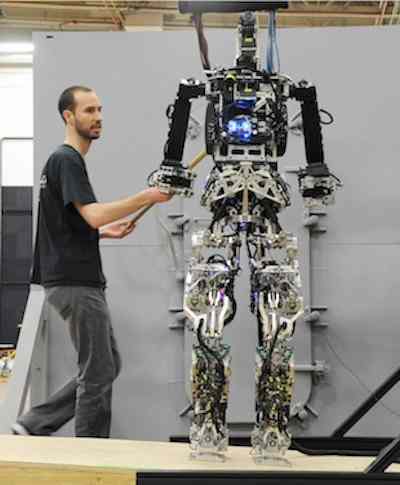 Fighting fires, with their extreme unpredictability, high temperatures and the resulting damage to structures, can prove challenging for even the most seasoned firefighter. Autonomous robots that can walk directly into flames and see through black smoke would be a handy assistant to any fire chief for the control and assessment of fires.
Fighting fires, with their extreme unpredictability, high temperatures and the resulting damage to structures, can prove challenging for even the most seasoned firefighter. Autonomous robots that can walk directly into flames and see through black smoke would be a handy assistant to any fire chief for the control and assessment of fires.
It turns out the U.S. Naval Research Laboratory has for several years been developing just such a safety tool to be used aboard Navy ships.
As any sailor knows, shipboard fire are deadly. So, researchers have taken a humanoid robot created at Virgina Tech and adapted it for firefighting on ships. In a collaboration with the University of Pennsylvania, the robot, named SAFFiR (Shipboard Autonomous Firefighting Robot) recently demonstrated its sea legs.
“SAFFiR is being designed to move autonomously throughout a ship to learn ship layout, interact with people, patrol for structural anomalies, and handle many of the dangerous firefighting tasks that are normally performed by humans,” said Thomas McKenna, a manager for the Naby’s Computational Neuroscience and Biorobotics programs.
The robot is designed with enhanced multi-modal sensor technology for advanced navigation and a sensor suite that includes a camera, gas sensor, and stereo infrared (IR) and ultraviolet (UV) cameras to enable it to see through smoke and detect sources of excess heat. SAFFiR is also capable of walking in all directions, balancing in sea state conditions, and traversing obstacles such as ‘knee-knocker’ bulkhead openings.
At the Naval Research Lab’s Laboratory for Autonomous Systems Research, the students demonstrated the complex motion, agility, and walking algorithms of the robots over natural and manmade terrain and simulated shipboard sea state (pitch and roll) conditions. Also demonstrated were ‘seek-and-find’ algorithms for locating a fire emergency, in this case an open flame, and the use of ‘artificial muscle’ for the lifting and activation of fire suppression equipment, such as opening a water valve, lifting and walking with a fire hose, and activating a nozzle.
To protect robotic mechanisms and electronics from intense heat, researchers at NRL’s Advanced Materials Section have developed a class of light-weight, high temperature resin that can be molded to any shape and remain strong at temperatures up to 500 degrees Celsius. Later this year, the robotic teams are expecting to conduct shipboard trials onboard the Navy’s only full-scale fire test ship, the ex-USS Shadwell, moored in Mobile, Ala.
Learn more at the NRL website – Thanks to Harley Hahn for sending the link!



















